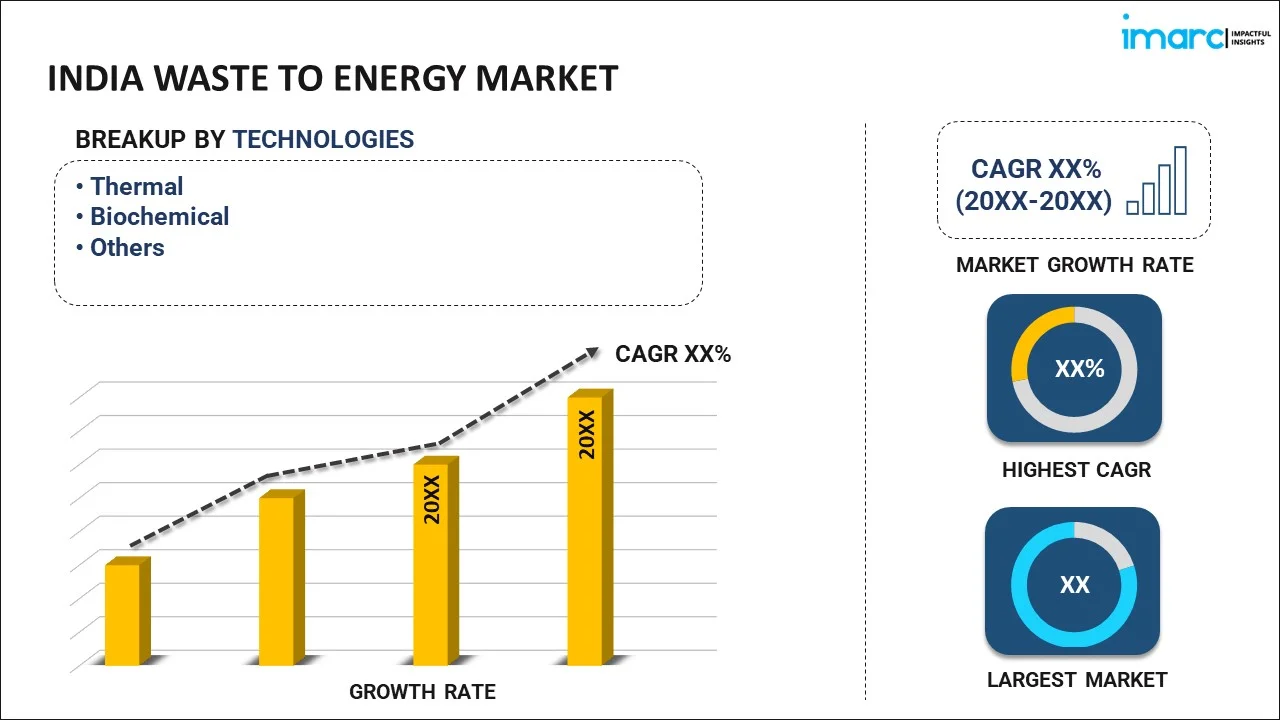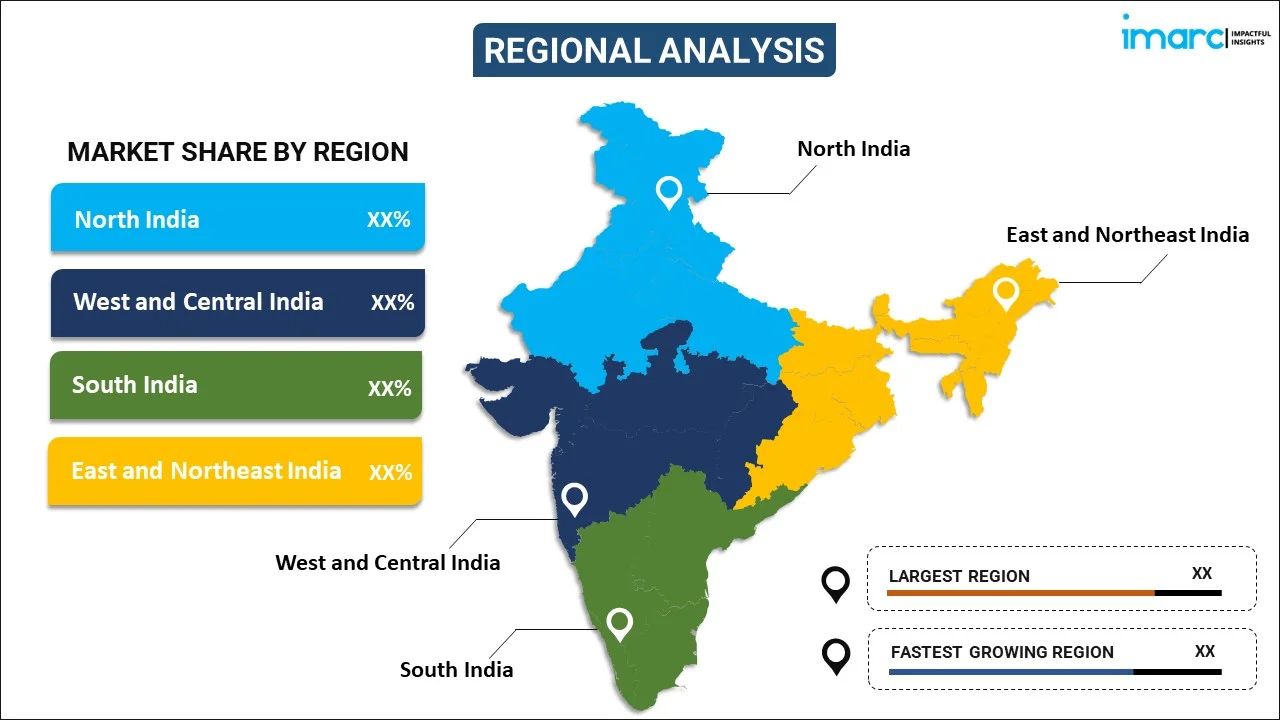
India Waste to Energy Market Report by Technology (Thermal, Biochemical, and Others), Waste Type (Municipal Waste, Process Waste, Agriculture Waste, Medical Waste, and Others), and Region 2025-2033
Market Overview:
India waste to energy market size is projected to exhibit a growth rate (CAGR) of 2.66% during 2025-2033. The increasing advances in waste to energy technologies, such as improved combustion processes, gasification, and anaerobic digestion, which make these solutions more efficient, cost-effective, and environmentally friendly, are driving the market.
|
Report Attribute
|
Key Statistics
|
|---|---|
|
Base Year
|
2024 |
|
Forecast Years
|
2025-2033
|
|
Historical Years
|
2019-2024
|
| Market Growth Rate (2025-2033) | 2.66% |
Waste to energy (WTE) is a process that converts non-recyclable waste materials into electricity or heat. This method helps address the dual challenges of waste disposal and energy production. During WTE, various technologies such as incineration, gasification, or anaerobic digestion are employed to extract energy from municipal solid waste, industrial waste, or agricultural residues. The combustion of waste generates heat, which is used to produce steam, subsequently driving turbines to generate electricity. WTE not only reduces the volume of waste in landfills but also harnesses energy from materials that would otherwise contribute to environmental pollution. However, concerns about air emissions and the potential release of harmful byproducts highlight the importance of implementing advanced pollution control technologies in WTE facilities to mitigate environmental impacts. As societies strive for sustainable waste management, WTE presents an alternative method to recover value from discarded materials while contributing to the generation of clean energy.
India Waste to Energy Market Trends:
The waste to energy market in India is gaining momentum, driven by several key factors. Firstly, the increasing regional population and urbanization have led to a surge in waste generation, creating a pressing need for sustainable waste management solutions. Additionally, stringent environmental regulations aimed at curbing greenhouse gas emissions and promoting cleaner energy sources have propelled the adoption of WTE technologies. Furthermore, the rising awareness of the finite nature of conventional energy resources has shifted focus towards alternative and renewable energy options, with WTE emerging as a viable solution. Moreover, technological advancements and innovations in WTE processes have improved efficiency, making these technologies more attractive to investors. The economic benefits associated with converting waste into energy, such as reduced landfill usage and potential revenue streams from the sale of electricity and by-products, contribute to the market's growth. Furthermore, increasing government support and incentives for WTE projects, coupled with a growing emphasis on circular economy principles, further bolster the WTE market. In essence, these interconnected drivers underscore the transformative potential of WTE solutions in addressing both environmental and energy challenges on a regional scale.
India Waste to Energy Market Segmentation:
IMARC Group provides an analysis of the key trends in each segment of the market, along with forecasts at the country level for 2025-2033. Our report has categorized the market based on technology and waste type.
Technology Insights:

- Thermal
- Incineration
- Pyrolysis
- Gasification
- Biochemical
- Others
The report has provided a detailed breakup and analysis of the market based on the technology. This includes thermal (incineration, pyrolysis, and gasification), biochemical, and others.
Waste Type Insights:
- Municipal Waste
- Process Waste
- Agriculture Waste
- Medical Waste
- Others
A detailed breakup and analysis of the market based on the waste type have also been provided in the report. This includes municipal waste, process waste, agriculture waste, medical waste, and others.
Regional Insights:

- North India
- West and Central India
- South India
- East and Northeast India
The report has also provided a comprehensive analysis of all the major regional markets, which include North India, West and Central India, South India, and East and Northeast India.
Competitive Landscape:
The market research report has also provided a comprehensive analysis of the competitive landscape in the market. Competitive analysis such as market structure, key player positioning, top winning strategies, competitive dashboard, and company evaluation quadrant has been covered in the report. Also, detailed profiles of all major companies have been provided.
India Waste to Energy Market Report Coverage:
| Report Features | Details |
|---|---|
| Base Year of the Analysis | 2024 |
| Historical Period | 2019-2024 |
| Forecast Period | 2025-2033 |
| Units | Million USD |
| Scope of the Report | Exploration of Historical Trends and Market Outlook, Industry Catalysts and Challenges, Segment-Wise Historical and Future Market Assessment:
|
| Technologies Covered |
|
| Waste Types Covered | Municipal Waste, Process Waste, Agriculture Waste, Medical Waste, Others |
| Regions Covered | North India, West and Central India, South India, East and Northeast India |
| Customization Scope | 10% Free Customization |
| Post-Sale Analyst Support | 10-12 Weeks |
| Delivery Format | PDF and Excel through Email (We can also provide the editable version of the report in PPT/Word format on special request) |
Key Questions Answered in This Report:
- How has the India waste to energy market performed so far and how will it perform in the coming years?
- What has been the impact of COVID-19 on the India waste to energy market?
- What is the breakup of the India waste to energy market on the basis of technology?
- What is the breakup of the India waste to energy market on the basis of waste type?
- What are the various stages in the value chain of the India waste to energy market?
- What are the key driving factors and challenges in the India waste to energy?
- What is the structure of the India waste to energy market and who are the key players?
- What is the degree of competition in the India waste to energy market?
Key Benefits for Stakeholders:
- IMARC’s industry report offers a comprehensive quantitative analysis of various market segments, historical and current market trends, market forecasts, and dynamics of the India waste to energy market from 2019-2033.
- The research report provides the latest information on the market drivers, challenges, and opportunities in the India waste to energy market.
- Porter's five forces analysis assist stakeholders in assessing the impact of new entrants, competitive rivalry, supplier power, buyer power, and the threat of substitution. It helps stakeholders to analyze the level of competition within the India waste to energy industry and its attractiveness.
- Competitive landscape allows stakeholders to understand their competitive environment and provides an insight into the current positions of key players in the market.
Need more help?
- Speak to our experienced analysts for insights on the current market scenarios.
- Include additional segments and countries to customize the report as per your requirement.
- Gain an unparalleled competitive advantage in your domain by understanding how to utilize the report and positively impacting your operations and revenue.
- For further assistance, please connect with our analysts.
 Inquire Before Buying
Inquire Before Buying
 Speak to an Analyst
Speak to an Analyst
 Request Brochure
Request Brochure
 Request Customization
Request Customization




.webp)




.webp)












